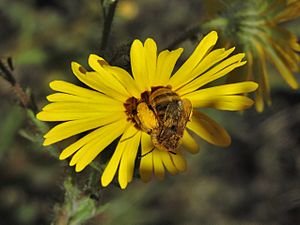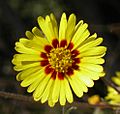Madia elegans facts for kids
Quick facts for kids Madia elegans |
|
|---|---|
 |
|
| Scientific classification | |
| Kingdom: | |
| (unranked): | |
| (unranked): | |
| (unranked): | |
| Order: | |
| Family: | |
| Genus: |
Madia
|
| Species: |
M. elegans
|
| Binomial name | |
| Madia elegans D.Don ex Lindl.
|
|
Madia elegans, often called the common madia, is a beautiful wild plant. It's an annual herbaceous plant, meaning it grows, flowers, and produces seeds all in one year. This plant is part of the daisy family, just like sunflowers and dandelions!
Contents
Where the Common Madia Grows
The Madia elegans plant naturally grows in western North America. You can find it from south-central Washington (state) all the way down to northern Baja California. It likes dry, open areas like forests, grasslands, and places where the ground has been disturbed. You can spot it from low lands up to high mountains.
What the Common Madia Looks Like
The Madia elegans plant is covered with short, stiff hairs. It also has sticky glands, especially near its flowers. The flowers are quite showy and can look a bit different depending on the specific type of madia.
Usually, it has bright yellow, daisy-like blooms. These flowers have many thin petals, called ray flowers, and several small flowers in the center, called disk flowers. The whole flower can be bright yellow, or its center might be a different color, like white or even maroon.
Several strongly scented flowers grow at the end of a thin green stem. A cool fact about these flowers is that their ray petals curl up during the day. They open up in the late afternoon and stay open all night until mid-morning! You can see them flowering from April through early November.
The plant's leaves give off a fragrant oil. This is why it's sometimes called tarweed.
Seeds and Their Uses
The fruits of the Madia elegans are small seeds called achenes. Long ago, Native American tribes, like the Pomo and Miwok, used these seeds as food. They would bake them or grind them into flour to make bread or other dishes.
Types of Common Madia
There are a few different types, or subspecies, of Madia elegans:
- M. e. densifolia - known as showy tarweed
- M. e. elegans - the common madia
- M. e. vernalis - called spring madia
- M. e. wheeleri - known as Wheeler's tarweed
Images for kids
-
A Madia elegans flower in the Santa Monica Mountains
-
Madia elegans growing in the Santa Cruz Mountains
-
A close-up of the flower from San Joaquin County, California
-
Madia elegans found in Josephine County, Oregon





